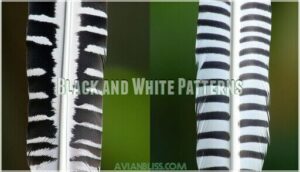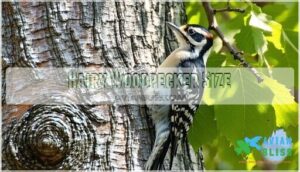This site is supported by our readers. We may earn a commission, at no cost to you, if you purchase through links.

Hairy woodpeckers stretch to 9 inches with pristine white outer tail feathers, preferring mature forest tree trunks. Males show different red patches too – downies sport solid red caps while hairies display split red patches with black stripes. The secret lies in remembering that everything about hairies is simply bigger and bolder.
Table Of Contents
- Key Takeaways
- Identifying Woodpeckers
- Plumage Patterns
- Size and Beak Shape
- Vocalizations
- Habitat Preferences
- Identifying Fledglings
- Feeding Habits
- Attracting Woodpeckers
- Behavioral Differences
- Woodpecker Identification Tips
- Frequently Asked Questions (FAQs)
- What is the difference between a downy and a Hairy Woodpecker?
- How rare is it to see a Downy Woodpecker?
- How do you identify a Hairy Woodpecker?
- Do all Downy Woodpeckers have red on them?
- Do downy and hairy woodpeckers have different nesting habits?
- How long do downy and hairy woodpeckers typically live?
- Do these woodpecker species migrate?
- Are there other similar species that could be confused with these two?
- What is the typical breeding season for each woodpecker type?
- Do downy and hairy woodpeckers interbreed?
- Conclusion
Key Takeaways
- Check the bill size first – You’ll instantly spot downy woodpeckers by their stubby bills (one-third head length) versus hairy woodpeckers’ robust bills that nearly match their head size.
- Look at tail feather patterns – You can distinguish them by examining outer tail feathers: downies have black spots on white feathers, while hairies display completely unmarked white outer tail feathers.
- Notice the size difference – You’ll see downy woodpeckers are sparrow-sized at 6.5 inches, while hairy woodpeckers stretch to 9 inches (nearly 50% larger).
- Observe their habitat preferences – You’ll find downies adapting to suburban backyards and feeders, while hairies prefer mature forests with larger trees for their stronger drilling needs.
Identifying Woodpeckers
You’ll often spot these two similar woodpeckers at your backyard feeder, but telling them apart isn’t as tricky as it seems
Bill Size Difference
When you first spot these woodpeckers, the bill size difference jumps out immediately. Think of it as nature’s toolbox – each species got perfectly sized equipment for their job.
Nature’s perfectly engineered tools reveal each woodpecker’s specialty at first glance
Here’s how to distinguish them by bill size:
- Downy Woodpecker Bill Size: Picture a delicate needle – their bill measures roughly one-third their head length, creating that "cute button" appearance.
- Hairy Woodpecker Bill Length Ratio: Imagine a sturdy chisel – their bill stretches nearly the full length of their head, giving them serious pecking force.
- Bill Strength Comparison: The Hairy’s robust bill delivers greater feeding efficiency when tackling thick bark and hardwood, while the Downy’s smaller tool works perfectly for softer materials.
- Evolutionary Advantage: This bill size variation prevents direct competition – Hairy woodpeckers excavate deeper holes in mature trees, while Downy vs Hairy woodpecker feeding strategies target different food sources entirely.
This size difference isn’t just cosmetic. It’s nature’s way of letting both species thrive without stepping on each other’s toes – or should we say, talons.
Overall Size Comparison
Spotting these Size Differences becomes easier when you understand the Relative Dimensions. Downy Woodpeckers measure about 6.5 inches—roughly sparrow-sized—while Hairy Woodpeckers stretch nearly 9 inches, approaching robin proportions.
This Mass Variation creates noticeable Visual Perception differences in the field. Size Deception can occur when viewing birds at distance, but comparing Length to familiar backyard birds helps overcome Measurement Challenges. The Weight difference is substantial too—Hairy Woodpeckers appear almost 50% bulkier.
When both species visit your feeder simultaneously, the size contrast becomes unmistakable, making identification straightforward.
Tail Feather Patterns
While Hairy Woodpeckers display pristine outer tail feathers that are completely white, Downy Woodpeckers showcase spotted outer tail feathers with distinctive black markings. This outer feather ID trick works whether you’re spotting variations during flight or when they’re clinging to tree bark.
Geographic differences and feather wear patterns can affect visibility, but these tail feathers remain your most reliable identifying feature.
Plumage Patterns
While both woodpeckers sport classic black-and-white plumage, their subtle differences can help you distinguish between them at a glance.
The key lies in examining their tail feathers and the male’s red head patch closely.
Black and White Patterns
Beyond size and bill differences, you’ll notice distinct black and white patterns that set these species apart. Downy Woodpecker and Hairy Woodpecker both sport striking monochrome plumage, but their Distinctive Markings tell different stories.
Here are four key Plumage Differences to watch for:
- Tail feather spots: Downy woodpeckers show black bars or spots on white outer tail feathers
- Clean white feathers: Hairy woodpeckers display unmarked, solid white outer tail feathers
- Pattern Variations: Regional populations may show slight Plumage Irregularities or Color Aberrations
- Hybrid Markings: Rare mixed patterns occasionally appear where ranges overlap, creating identification challenges
These Regional Differences in markings help with field identification, making tail patterns your most reliable visual cue.
Red Patch on Male Woodpeckers
Check out the red patch on male heads—it’s like nature’s ID badge! Male Downy Woodpeckers show off a solid, unsplit red patch, while Male Hairy Woodpecker heads sport a distinctive split red patch with a black stripe running through it.
This patch location and red intensity difference makes identification straightforward when you spot these plumage differences.
White Outer Tail Feathers
When examining tail feathers, you’ll notice both species share similar coloring patterns. However, the Outer Tail Feathers tell a different story:
- Downy Woodpecker: Features black spots or bars on white outer tail feathers
- Hairy Woodpecker: Displays completely unmarked, pure white outer tail feathers
- Visual Cues: Look for these Distinctive Markings during flight or perched positions
- Molting Patterns: Fresh feathers show clearest differences, while Feather Wear may obscure markings
This Camouflage Purpose helps with identification when other features aren’t visible.
Size and Beak Shape
When you’re looking at these two woodpeckers, size becomes your first clue since hairy woodpeckers are nearly 50% larger than their downy cousins.
The beak tells the real story though – downy woodpeckers sport a dainty bill that’s only about one-third the length of their head, while hairy woodpeckers pack a robust bill that’s nearly as long as their entire head.
Downy Woodpecker Size
You’ll quickly notice the Downy’s compact build when comparing these similar-looking species. This smaller woodpecker measures just 6-7 inches in Downy Length, making it roughly sparrow-sized. Downy Weight typically ranges from 0.7-1.0 ounces—lighter than most smartphones! Downy Measurements show minimal Downy Dimorphism between males and females in Downy Stature.
Key Differences become apparent when you spot both species together:
- Downy Woodpeckers look almost toy-like next to their larger cousins
- Their petite frame fits easily on thin branches and twigs
- You’ll often see them hanging upside-down on suet feeders
- They can access smaller crevices that Hairy Woodpeckers can’t reach
- Their compact size makes them incredibly agile climbers
Hairy Woodpecker Size
Hairy woodpeckers are substantially larger than their Downy cousins, measuring about nine inches long—nearly 50% bigger than Downy’s six-inch frame. Picture a Robin-sized bird and you’ll grasp a Hairy Woodpecker’s true size advantage.
Size Variability becomes tricky with measurement challenges when observing a solo bird. Sexual Dimorphism doesn’t affect overall size much, but habitat impact matters—these larger birds need bigger trees. Understanding their beak shape variations also aids identification. Compare the woodpecker to nearby objects or other birds for better perspective. This size difference is your most reliable field mark when distinguishing downy vs hairy woodpecker species.
Beak Shape Difference
Bill morphology reveals the most practical difference between these species. Picture the Downy Woodpecker’s dainty bill—it’s roughly one-third its head length, perfect for delicate work. The Hairy Woodpecker sports a robust bill nearly matching its head length, built for heavy-duty pecking mechanics.
Here’s what to look for:
- Bill size comparison: Downy’s resembles a toothpick, Hairy’s looks like a nail
- Feeding adaptations: Downy accesses small crevices, Hairy excavates deep holes
- Bill evolution: Each species developed tools matching their preferred prey size
These beak functionality differences aren’t random—they’re perfectly matched to each bird’s lifestyle and hunting strategy.
Vocalizations
When you’re trying to tell these two woodpeckers apart, listening to their calls can be just as helpful as looking at their size.
Each species has its own signature sound that’ll help you identify them even when they’re hidden behind tree bark, using their calls can be just as helpful.
Downy Woodpecker Calls
You’ll hear Downy woodpecker calls as short "pik" notes that sound friendly and high-pitched. Their whinny sound descends in pitch like a miniature horse, lasting about two seconds. Call frequency increases during breeding season, while individual variations help birds recognize each other. Environmental factors affect call pitch – these vocalizations concentrate energy at 1-6 kHz, matching their hearing sensitivity perfectly.
The Downy Woodpecker is common and can be found in urban areas and parks.
| Call Type | Characteristics |
|---|---|
| Pik Call | Sharp, short note repeated every half-second |
| Whinny Call | High-pitched, descending series lasting 2 seconds |
| Frequency Range | 1.5-6 kHz energy concentration |
| Seasonal Variation | More frequent during breeding season |
Hairy Woodpecker Calls
Hairy Woodpeckers sound like squeaky toys when they call! Their sharp "peek!" notes cut through forest noise at around 6 kHz. Unlike downies’ descending whinnies, hairy woodpecker calls stay steady in pitch. Call acoustics reveal their territorial calls often come in sequences of four to five notes. These call variations help distinguish them during downy vs hairy woodpecker identification.
Rattle duration extends longer than other woodpeckers’ similar sounds. They’re classified as being of Least Concern despite facing habitat challenges.
Drumming Patterns
Drumming serves as nature’s percussion section for Territory Marking and mate attraction. Downy Woodpeckers deliver slower, deliberate beats at 17 per second, while Hairy Woodpeckers create rapid-fire bursts reaching 26 beats per second. Think machine gun versus steady hammer. Drumming Duration also differs—Downy’s shorter 0.8-second sessions contrast with Hairy’s longer performances.
This Drumming Frequency difference makes Identifying Woodpeckers easier when visual Species Variation isn’t clear, complementing their distinct call patterns. Habitat loss can force vocal adjustments for birds in finding mates.
Habitat Preferences
You’ll find these woodpeckers in surprisingly different neighborhoods, even though they’re close relatives.
Downy woodpeckers adapt to almost anywhere with trees, from your backyard bird feeder to city parks, while hairy woodpeckers prefer the peace and quiet of mature forests with towering trees, and Downy woodpeckers are not limited to these areas.
Downy Woodpecker Habitat
These adaptable birds turn neighborhoods into their personal playgrounds. You’ll spot downy woodpeckers thriving in Urban Adaptations across various environments, from Suburban Gardens to Forest Edges. They’re less picky about Habitat than their hairy cousins, making them perfect backyard companions.
- Suburban Gardens: Frequent visitors to backyard feeders and ornamental trees
- Forest Edges: Prefer woodland borders where open spaces meet wooded areas
- Urban parks: Excellent Nesting Sites in mature shade trees and dead snags
Hairy Woodpecker Habitat
While downies thrive in suburbs, Hairy Woodpeckers prefer the seclusion of mature forests with towering trees. These birds show strong forest dependence, favoring both deciduous forests and coniferous forests over urban areas. You’ll find them drilling into thick bark that smaller woodpeckers can’t penetrate, making forested areas their primary habitat preference.
Species Habitat
Overlapping Habitats
Something special happens where downy and hairy woodpecker territories meet—habitat overlap creates fascinating coexistence strategies. You’ll spot both species in mixed forests, large suburban parks, and forest edges where suburban expansion meets mature woods.
Forest fragmentation actually increases these overlap zones, bringing the adaptable downy woodpecker into traditional hairy woodpecker territory. While resource competition exists, they’ve learned to share space by using different tree sizes and foraging heights, making identification trickier but observation more rewarding. Habitat selection prioritizes available food sources.
Identifying Fledglings
You’ll find that identifying young downy and hairy woodpeckers requires looking at the same key features as adults, though the differences can be more subtle in fledglings.
Young birds often stick close to their parents during their first few weeks, so watching family groups can help you confirm which species you’re observing.
Young Downy Woodpeckers
While understanding habitat preferences helps you spot adult birds, identifying young Downy Woodpeckers requires different observation skills. You’ll notice fledgling plumage looks similar to adults but often appears fluffier and less defined.
Here are key features that’ll help you identify young Downies:
- Black-spotted tail feathers – Those distinctive markings on white outer tail feathers remain consistent from fledgling to adult
- Smaller bill size – Even juveniles show that characteristic stubby beak, about one-third their head length
- Red patch development – Young males start showing solid red patches early, unlike their Hairy cousins’ split patches
- Compact size – Fledglings maintain that petite 6-inch frame, making them noticeably smaller than young Hairy woodpeckers
- Active begging behavior – You’ll often hear their high-pitched calls as they follow parents around
Their juvenile diet consists primarily of insects, though parents also bring seeds and berries. Parental care is intensive – adults feed fledglings for weeks after they leave the nest. During development stages, young Downies perfect their pecking technique while staying close to family groups, making identification easier through these nesting habits.
Young Hairy Woodpeckers
While adult hairy woodpeckers show clear identification features, young ones can throw you curveballs. Juvenile plumage often displays yellow patches instead of red, making downy vs hairy woodpecker identification trickier. Nestling development includes additional black side markings and white back stripes that fade with age.
| Feature | Young Hairy |
|---|---|
| Head patch | Yellow (not red) |
| Side markings | Extra black bars |
| Back pattern | White stripes present |
Parental care involves teaching learning to forage skills, with parents demonstrating proper tree-tapping techniques. Vocal development progresses as fledglings practice their signature calls, though they won’t master the adult’s sharp "peek" sound immediately. These bird species comparison challenges make patience key when identifying juvenile differences.
Parent-Offspring Identification
When young hairy woodpeckers show fledgling plumage differences from their downy woodpecker cousins, watch the parents! Parental care reveals the truth since adults display classic identification features.
Here’s what you’ll spot when observing these family feeding sessions:
- Adult bill size – Parent’s beak length instantly shows species identity
- Outer tail feathers – Spotted (Downy) or plain white (Hairy) on adults
- Nestling calls – Young mimic their parents’ distinctive vocalizations
- Juvenile behavior – Learning foraging techniques specific to each species
- Size comparison – Parent-offspring size ratio differs between species dramatically
Feeding Habits
While both species share similar dietary preferences, you’ll notice subtle differences in their feeding techniques and food choices that can help with identification.
Downy woodpeckers tend to forage more on smaller branches and twigs, while hairy woodpeckers focus their efforts on larger tree trunks and thicker limbs, which can be related to their feeding techniques.
Insect Diet
You’ll find both Downy Woodpeckers and hairy woodpeckers share an impressive appetite for insects, but their different sizes create distinct feeding patterns. Downy woodpeckers excel at larval consumption from thin stems and smaller branches, while hairy woodpeckers target beetle preference in thicker bark.
Both show ant specialization and adapt their insect variety based on seasonal diet changes, making insects their primary fuel source year-round. Supplementing their natural foraging, you can attract them with a specialized insect feeder.
Fruit and Seed Consumption
Beyond insects, these woodpeckers have quite the sweet tooth! Both species enthusiastically visit backyard feeders for suet cakes and enjoy seasonal treats throughout the year.
Here’s what you’ll see them munching on:
- Berry preferences: They favor elderberries, dogwood berries, and sumac fruits, especially during fall migration periods when these colorful snacks are abundant.
- Seed types: Sunflower seeds top their list, along with maple seeds and acorns. Their bills handle smaller seeds better than larger varieties.
- Seasonal variation: Summer brings orchard foraging for cherries and apples, while winter means more suet dependency and cached seed consumption.
This varied diet keeps them healthy year-round, supplementing their protein-rich insect meals with energy-packed plant foods. Offering them high-calorie energy sources can be especially beneficial.
Unique Feeding Behaviors
Downy and hairy woodpeckers showcase distinct foraging techniques that set them apart. Downies excel at exploiting weed stalks and cattails, while hairies stick strictly to trees. Their winter feeding strategies differ dramatically too.
| Behavior | Downy Woodpecker | Hairy Woodpecker |
|---|---|---|
| Foraging Techniques | Peer-and-poke on thin branches | Tap-and-listen on tree trunks |
| Specialized Diets | Goldenrod gall grubs, weed insects | Bark beetle larvae, deep wood boring insects |
| Food Storage | No caching behavior | Limited caching in winter |
Both visit suet from birdfeeders regularly, but downies show remarkable flexibility—they’ll even sip nectar from hummingbird feeders when insects are scarce! To attract these birds, consider offering a specialized suet product.
Attracting Woodpeckers
Once you know how to identify these two woodpeckers, you’ll want to attract them to your yard for better observation opportunities.
Both species respond well to the same basic offerings, though their habitat preferences might influence which one visits more often.
Downy Woodpecker Attraction
Anyone can transform their yard into a downy woodpecker paradise with the right setup. These charming little birds can’t resist well-placed attractions that meet their basic needs.
- Suet feeders filled with high-quality beef fat mixed with nuts and seeds
- Wire mesh baskets positioned near trees for quick escapes from predators
- Nesting boxes with 1.5-inch holes placed 10-15 feet high
- Native plants that produce natural berries and nuts year-round
- Water source like birdbaths refreshed regularly for drinking and bathing
Avoiding pesticides keeps their insect food supply healthy, while sunflower seeds supplement their diet perfectly.
Hairy Woodpecker Attraction
While Downy Woodpeckers adapt to suburban settings, attracting hairy woodpeckers requires different forest management approaches. These birds prefer mature woodland environments with towering dead trees for nesting habitat.
Attraction Details
Tips for Woodpecker-Friendly Yards
Creating a woodpecker haven requires more than just hanging feeders. Transform your backyard into an irresistible destination by providing everything these fascinating feeder birds need to thrive.
Start with suet feeders filled with high-energy treats—woodpeckers can’t resist this protein-packed snack. Position them near tree trunks where birds feel secure while dining. Your insect control strategy matters too; skip pesticides and let nature’s cleanup crew handle pest problems naturally.
Here’s your woodpecker attraction checklist:
- Native trees like oak, maple, and cherry provide natural food sources and nesting sites
- Multiple water sources including shallow birdbaths and dripping fountains
- Dead tree snags left standing for foraging and cavity excavation
- Suet from birdfeeders offered year-round, especially during breeding season
- Mixed habitat zones combining open spaces with dense woodland areas
Understanding habitat preferences helps you cater to both species—downies appreciate suburban gardens while hairys prefer mature forest edges. This approach transforms ordinary yards into backyard birds paradise, supporting local woodpecker populations while giving you front-row seats to their entertaining antics.
Behavioral Differences
You’ll notice these woodpeckers behave quite differently once you start watching them closely.
Downy woodpeckers are the bold, social butterflies of the pair, while hairy woodpeckers tend to be more cautious and solitary in their daily activities, making them the quieter, more solitary counterparts.
Downy Woodpecker Behavior
When you’re watching Downy woodpeckers in action, you’ll notice their curious and playful foraging strategies. These adaptable birds explore backyards with remarkable urban adaptation, often working in pairs during their mating rituals. Their social hierarchy stays relaxed compared to larger woodpeckers.
| Behavior Aspect | Downy Characteristics |
|---|---|
| Foraging Strategies | Quick, agile movements on thin branches |
| Social Hierarchy | Cooperative pairs, minimal aggression |
| Nesting Habits | Small cavities in dead wood, nest boxes |
| Urban Adaptation | Thrives in suburbs, parks, and gardens |
Their nesting habits include drilling precise holes in dead trees, showing remarkable habitat flexibility from forests to your backyard feeder.
Hairy Woodpecker Behavior
Most hairy woodpeckers display more aggressive behavior than their downy cousins. You’ll notice these bold birds defending prime territory with fierce determination, especially around mature forest habitats where they thrive. These birds play a role in maintaining ecosystem balance by controlling insect populations.
Here’s what makes hairy woodpecker behavior distinct:
- Territorial Defense: They’ll chase away intruders from feeding spots with loud calls and aggressive posturing
- Foraging Strategies: These birds excavate deeper holes in dead wood, using their powerful bills for intensive insect hunting
- Mating Rituals: Males perform elaborate drumming displays on resonant dead branches to attract mates during breeding season
- Nesting Habits: They prefer excavating cavities high in large, dead trees rather than smaller branches
Social Interactions
Both species show distinct social patterns that reveal key behavior differences. Downy woodpeckers establish loose dominance hierarchies during territorial disputes, with older birds typically dominating younger ones in feeding situations. They’re more social than their larger cousins, often joining mixed-species flocks during winter months.
Hairy woodpeckers prefer solitude, showing stronger territory defense behaviors and less cooperative breeding tendencies. Interspecies relations between these bird species involve direct competition for nesting sites, with pair bonding occurring primarily in spring, which is a key aspect of their territory defense behaviors.
Woodpecker Identification Tips
You’ll become a confident woodpecker detective when you combine multiple identification clues instead of relying on just one feature.
Watch their behavior at feeders and listen to their calls while noting size differences—this triple approach makes identification foolproof even when lighting conditions aren’t perfect.
Combining Identification Methods
Successful downy vs hairy woodpecker identification requires holistic identification—combining multiple features instead of relying on just one clue. These two species can fool even experienced birders, so you’ll need to gather contextual clues from different angles.
Here’s your three-step approach to mastering woodpecker ID:
- Size and Bill Assessment: Compare bill size to head length and overall bird dimensions. Downy woodpeckers sport stubby bills about one-third their head length, while hairy woodpeckers have longer bills nearly matching head size.
- Behavioral Analysis: Watch feeding patterns and habitat preferences. You’ll spot behavioral differences in how they move and where they hang out—suburban areas versus deep forests.
- Pattern Recognition: Check outer tail feathers for spots (downy) versus plain white (hairy), plus examine male red patches for splits or solid coloring. Regional differences and seasonal variation can affect these markings slightly.
Observing Woodpecker Behavior
Beyond identifying features, watching how these birds move and behave reveals telling differences. Downy woodpeckers and hairy woodpeckers show distinct foraging strategies and social behaviors that help with identification.
| Behavior | Downy Woodpecker | Hairy Woodpecker |
|---|---|---|
| Foraging | Works on smaller branches and twigs | Focuses on tree trunks and larger limbs |
| Drumming | 17 beats per second for territory defense | 25 beats per second, more aggressive |
| Social Hierarchy | More tolerant around feeders | Dominant, often chases other birds away |
| Nesting Habits | Excavates in dead wood or soft trees | Prefers harder wood, deeper excavations |
Notice their drumming purposes during breeding season. Hairy woodpeckers drum faster and louder for territory defense, while downies use gentler rhythms. Diet and behavior also differ—downies acrobatically forage on thin branches, but hairies stick to sturdy trunks where their stronger bills work best.
Consulting Field Guides and Experts
While studying behavior patterns helps, sometimes you need backup to nail down tricky identifications. Guidebook Accuracy becomes your best friend when field observations leave you scratching your head.
Expert Validation from local birding groups transforms guesswork into confident identification. These folks have logged thousands of hours watching both Downy and Hairy woodpeckers, spotting Regional Variations that might throw off beginners. They’ll share stories about that one weird Hairy with spotted tail feathers or explain why Photographic Evidence sometimes lies.
Online Resources offer instant help through apps like eBird and Merlin. Here’s how to maximize these tools:
- Cross-reference multiple sources – Don’t rely on just one field guide for Bird Species Differences
- Join local Facebook birding groups for real-time Woodpecker Identification help
- Upload photos to iNaturalist where experts provide Bird Identification feedback
Remember, even seasoned birders mix up these species occasionally. The key is combining your field observations with reliable resources to build confidence in distinguishing these look-alike woodpeckers.
Frequently Asked Questions (FAQs)
What is the difference between a downy and a Hairy Woodpecker?
Like twins with different wardrobes, you’ll spot the key differences in size and bills.
Hairy woodpeckers are 50% larger with bills nearly matching their head length, while downy woodpeckers sport stubby bills one-third their head size.
How rare is it to see a Downy Woodpecker?
You’ll spot Downy Woodpeckers frequently since they’re North America’s most common woodpecker. They thrive in suburbs, parks, and backyards, making them regular visitors to feeders and easily observable year-round residents.
How do you identify a Hairy Woodpecker?
Measuring nearly 9 inches tall, you’ll spot a Hairy Woodpecker by its robust size, long bill matching its head length, and pristine white outer tail feathers without spots.
Do all Downy Woodpeckers have red on them?
No, only male Downy Woodpeckers have red patches on their heads. Females lack this colorful marking entirely, showing just black and white plumage patterns.
You’ll spot the bright red patch on males’ napes.
Do downy and hairy woodpeckers have different nesting habits?
Building their homes like feathered architects, you’ll find both species excavate similar cavities in dead wood, though Hairy Woodpeckers typically choose larger, older trees while Downys adapt to smaller branches and poles.
How long do downy and hairy woodpeckers typically live?
You’ll find both species living around 4-7 years in the wild, though some lucky birds reach 12 years. Captive woodpeckers often live longer with consistent food and protection from predators.
Do these woodpecker species migrate?
Looking for year-round neighbors? You’ll find both downy and hairy woodpeckers staying put throughout the seasons.
These species don’t migrate—they’re non-migratory residents that stick around your area all year long.
Are there other similar species that could be confused with these two?
Several other black-and-white woodpeckers can trip you up. Red-bellied and Red-headed Woodpeckers have similar patterns but show red on their bodies.
Pileated Woodpeckers are crow-sized with distinctive crests, making identification easier despite their black-and-white coloring.
What is the typical breeding season for each woodpecker type?
Like ancient scribes marking territory on papyrus, both woodpecker species breed from April through July. You’ll spot them excavating fresh nest holes in spring, with peak activity occurring during May and June when insect prey abundance supports their growing families.
Do downy and hairy woodpeckers interbreed?
These distinct species don’t interbreed in nature.
You won’t find hybrids between them despite their similar looks.
They’re genetically different enough that crossbreeding simply doesn’t occur, even where their ranges overlap.
Conclusion
Mastering the art of distinguishing these feathered doppelgangers becomes second nature once you’ve practiced these identification techniques.
Remember that downy vs hairy woodpecker identification hinges on size, bill proportions, and tail markings as your primary clues.
You’ll find downies at your suet feeders more often, while hairies prefer drumming on larger tree trunks.
With patience and these field marks in mind, you’ll confidently separate these look-alike species during your next backyard birdwatching adventure.
- https://www.nps.gov/shen/learn/nature/downy-woodpecker.htm
- https://www.allaboutbirds.org/guide/Downy_Woodpecker/species-compare/
- https://stateofthebirds.nhaudubon.org/bird_database/hairy-woodpecker/
- https://a-z-animals.com/animals/hairy-woodpecker/
- https://www.chicagobirder.org/blog/2020/12/17/dans-feathursday-feature-hairy-and-downy-woodpeckers
















